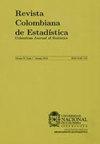Bahadur’s Stochastic Comparison of Combining infinitely Independent Tests in Case of Extreme Value Distribution
Q3 Mathematics
引用次数: 0
Abstract
For simple null hypothesis, given any non-parametric combination method which has a monotone increasing acceptance region, there exists a problem for which this method is most powerful against some alternative. Starting from this perspective and recasting each method of combining pvalues as a likelihood ratio test, we present theoretical results for some of the standard combiners which provide guidance about how a powerful combiner might be chosen in practice. In this paper we consider the problem of combining n independent tests as n → ∞ for testing a simple hypothesis in case of extreme value distribution (EV(θ,1)). We study the six free-distribution combination test producers namely; Fisher, logistic, sum of p-values, inverse normal, Tippett’s method and maximum of p-values. Moreover, we studying the behavior of these tests via the exact Bahadur slope. The limits of the ratios of every pair of these slopes are discussed as the parameter θ → 0 and θ → ∞. As θ → 0, the logistic procedure is better than all other methods, followed in decreasing order by the inverse normal, the sum of p-values, Fisher, maximum of p-values and Tippett’s procedure. Whereas, θ → ∞ the logistic and the sum of p-values procedures are equivalent and better than all other methods, followed in decreasing order by Fisher, the inverse normal, maximum of p-values and Tippett’s procedure.极值分布下无限独立组合检验的Bahadur随机比较
对于简单零假设,给定任何具有单调递增接受域的非参数组合方法,存在该方法对某些替代方法最有效的问题。从这个角度出发,将组合值的每种方法重新定义为似然比检验,我们提出了一些标准组合器的理论结果,这些结果为在实践中如何选择强大的组合器提供了指导。在极值分布(EV(θ,1))的情况下,考虑n个独立检验组合为n→∞检验简单假设的问题。研究了6个自由分布组合试验生产者;Fisher, logistic, p值和,反正态,Tippett方法,p值最大值。此外,我们还通过精确的Bahadur斜率来研究这些试验的行为。以θ→0和θ→∞为参数,讨论了每对斜率比值的极限。当θ→0时,逻辑斯蒂法优于其他方法,依次为正态反法、p值和法、Fisher法、p值最大值法和Tippett法。而θ→∞时,逻辑过程与p值和过程是等价的,且优于其他所有方法,其次是Fisher法、反正态法、p值最大值法和Tippett法。
本文章由计算机程序翻译,如有差异,请以英文原文为准。
求助全文
约1分钟内获得全文
求助全文
来源期刊

Revista Colombiana De Estadistica
STATISTICS & PROBABILITY-
CiteScore
1.20
自引率
0.00%
发文量
0
审稿时长
>12 weeks
期刊介绍:
The Colombian Journal of Statistics publishes original articles of theoretical, methodological and educational kind in any branch of Statistics. Purely theoretical papers should include illustration of the techniques presented with real data or at least simulation experiments in order to verify the usefulness of the contents presented. Informative articles of high quality methodologies or statistical techniques applied in different fields of knowledge are also considered. Only articles in English language are considered for publication.
The Editorial Committee assumes that the works submitted for evaluation
have not been previously published and are not being given simultaneously for publication elsewhere, and will not be without prior consent of the Committee, unless, as a result of the assessment, decides not publish in the journal. It is further assumed that when the authors deliver a document for publication in the Colombian Journal of Statistics, they know the above conditions and agree with them.
 求助内容:
求助内容: 应助结果提醒方式:
应助结果提醒方式:


